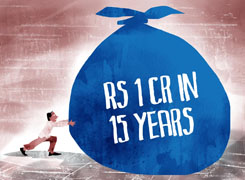Can I Turn 1 Crore into 5 Crore in 10 Years?
Ramalingam Kalirajan |10908 Answers |Ask -Follow
Mutual Funds, Financial Planning Expert - Answered on Aug 23, 2024
He has an MBA in finance from the University of Madras and is a certified financial planner.
He is the director and chief financial planner at Holistic Investment, a Chennai-based firm that offers financial planning and wealth management advice.... more

I have 1 crore cash .... How can I make 5 crore in next 10 years
Power of Compounding
Compounding is your strongest ally in achieving such growth. The longer your money stays invested, the more it can grow. The key is to choose investment avenues that offer both growth potential and compounding benefits.
Choosing the Right Investment Mix
To achieve your goal, you need a balanced investment portfolio. This means spreading your investments across various types of mutual funds. Consider a mix of equity funds, which offer high growth potential, and balanced funds, which offer stability.
Equity Mutual Funds: Equity funds should form the core of your investment. They have the potential to generate higher returns over the long term. Choose funds managed by experienced fund managers.
Balanced or Hybrid Funds: These funds invest in both equity and debt instruments. They offer moderate growth with lower risk. This helps in cushioning your portfolio against market volatility.
Avoid Index Funds: Index funds only track the market. They don't try to outperform it. Actively managed funds aim to deliver better returns than the index. With an ambitious target, actively managed funds could serve you better.
Importance of Regular Investment
Investing your Rs. 1 crore in one go can be risky. Instead, consider a Systematic Investment Plan (SIP). This spreads your investment over time and reduces the impact of market volatility.
Systematic Investment Plan (SIP): Start a SIP in your chosen mutual funds. This approach will help you average out the purchase cost and manage risks better.
Top-Up Your SIP: Consider increasing your SIP amount every year by 10-20%. This strategy will accelerate your corpus growth.
Role of Diversification
Don’t put all your money in one type of investment. Diversifying your portfolio will spread the risk and increase the chances of achieving your goal.
Diversify Across Sectors: Invest in mutual funds that focus on different sectors. This way, if one sector underperforms, others can balance it out.
Diversify Across Market Capitalisation: Include funds that invest in large-cap, mid-cap, and small-cap stocks. Large-caps offer stability, while mid and small-caps offer higher growth potential.
Avoiding High-Risk Investments
While it may be tempting to go for high-risk investments like direct stocks or sector-specific funds, they can be volatile. Your focus should be on consistent growth rather than chasing quick returns.
Avoid Direct Stock Investments: Stocks can be unpredictable. For your goal, mutual funds are a safer and more reliable option.
Avoid Real Estate and Annuities: Real estate is not liquid, and annuities offer lower returns. Stick to mutual funds for better growth potential.
Regular Review and Rebalancing
Your investment strategy needs regular monitoring. As market conditions change, your portfolio may need adjustments.
Review Quarterly: Check your portfolio’s performance every quarter. This will help you stay on track to meet your financial goals.
Rebalance Annually: Rebalancing ensures your portfolio stays aligned with your risk tolerance and goals. Shift funds from one category to another based on performance and future outlook.
The Role of a Certified Financial Planner
Having a Certified Financial Planner (CFP) by your side can be beneficial. They can guide you in selecting the right mutual funds, adjusting your strategy, and keeping you focused on your goals.
Expert Guidance: A CFP will help you navigate market uncertainties and keep your investments aligned with your financial plan.
Tax Efficiency: A CFP can also help you plan tax-efficient withdrawals and investments, ensuring you keep more of your returns.
Final Insights
Your goal of turning Rs. 1 crore into Rs. 5 crores in 10 years is achievable with the right strategy. Focus on a diversified mutual fund portfolio, regular SIPs, and annual reviews to keep your investments on track.
Best Regards,
K. Ramalingam, MBA, CFP,
Chief Financial Planner,
www.holisticinvestment.in
You may like to see similar questions and answers below
Ulhas Joshi |280 Answers |Ask -Follow
Mutual Fund Expert - Answered on May 18, 2023
Ramalingam Kalirajan |10908 Answers |Ask -Follow
Mutual Funds, Financial Planning Expert - Answered on May 08, 2024
Ramalingam Kalirajan |10908 Answers |Ask -Follow
Mutual Funds, Financial Planning Expert - Answered on Jun 20, 2024
Ramalingam Kalirajan |10908 Answers |Ask -Follow
Mutual Funds, Financial Planning Expert - Answered on Aug 21, 2024
Milind Vadjikar | Answer |Ask -Follow
Insurance, Stocks, MF, PF Expert - Answered on Sep 04, 2024
Ramalingam Kalirajan |10908 Answers |Ask -Follow
Mutual Funds, Financial Planning Expert - Answered on Dec 20, 2025
Ramalingam Kalirajan |10908 Answers |Ask -Follow
Mutual Funds, Financial Planning Expert - Answered on Dec 20, 2025
Naveenn Kummar |237 Answers |Ask -Follow
Financial Planner, MF, Insurance Expert - Answered on Dec 20, 2025
Ramalingam Kalirajan |10908 Answers |Ask -Follow
Mutual Funds, Financial Planning Expert - Answered on Dec 19, 2025
Nayagam P P |10859 Answers |Ask -Follow
Career Counsellor - Answered on Dec 19, 2025
Ramalingam Kalirajan |10908 Answers |Ask -Follow
Mutual Funds, Financial Planning Expert - Answered on Dec 19, 2025
Ramalingam Kalirajan |10908 Answers |Ask -Follow
Mutual Funds, Financial Planning Expert - Answered on Dec 19, 2025
Ramalingam Kalirajan |10908 Answers |Ask -Follow
Mutual Funds, Financial Planning Expert - Answered on Dec 19, 2025
Radheshyam Zanwar |6751 Answers |Ask -Follow
MHT-CET, IIT-JEE, NEET-UG Expert - Answered on Dec 19, 2025
Radheshyam Zanwar |6751 Answers |Ask -Follow
MHT-CET, IIT-JEE, NEET-UG Expert - Answered on Dec 19, 2025

























